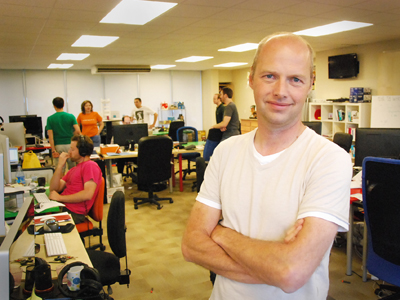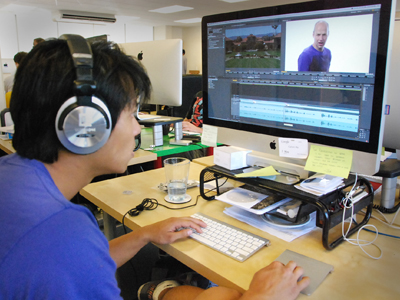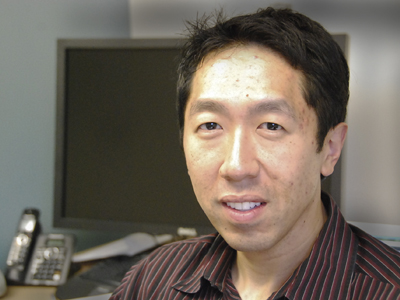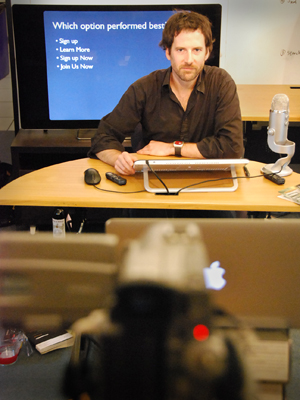In the fall of 2011, three Stanford University computer science professors tried an experiment. They threw their classrooms open to everyone in the world. With just a few emails and tweets, they offered free, online courses that anyone, anywhere could join. The classes went viral. More than 160,000 people signed up just for Professor Sebastian Thrun's artificial intelligence class. About 23,000 stayed with Thrun through the end of the semester and got a completion certificate.
"Which means we taught more students artificial intelligence than all the professors in the world combined," Thrun says with a mix of pride and wonder.
What followed has been described as a revolutionary moment in the history of higher education. Thrun left Stanford to start a free online college called Udacity. In a separate move, Stanford joined forces with a number of America's other leading colleges and universities to offer many of their courses -- with lectures, discussion groups, quizzes and tests -- free to anyone with an Internet connection. More than a million people have already signed up.
Proponents say that these "massively open online courses," or MOOCs, have the potential to make quality education a basic, international human right. MOOCs may also change the way students are taught on American campuses. And they may pose a grave threat to financially struggling colleges and universities with less prestigious brand names.
What almost everyone involved agrees on: no one knows where the massive-course movement is going. But change is afoot in higher education and powerful players are hustling to keep up.
"This is the year of disruption for education," says MIT computer scientist Anant Agarwal. "Things are moving extremely, extremely fast. The time is right. Because computing technologies are finally here. The Internet is available in large parts of the world. Computers and tablets have become relatively low-cost. I also think that open courseware created a movement where people are comfortable putting all sorts of courses online for free."
From Palo Alto to Pakistan
The Udacity headquarters is just down the road from Stanford's Palo Alto, Calif., campus. The place has the hastily-furnished look of a political campaign headquarters. Computers and cables are everywhere. Whiteboards are covered with inscrutable equations and color-coded action plans. Bike helmets and backpacks are strewn across the floor. A kitchen in the corner offers free fuel -- cereal, snacks and energy drinks.
A team of about 30 people -- professors, computer programmers, designers, video editors and college students -- work at oversized monitors creating and running Udacity's growing catalog of online courses. The current offerings all involve science and computers: statistics, software testing, cryptology and web engineering. Sebastian Thrun and his partners created this free, self-proclaimed "21st century university" to expand on the success of Thrun's massive artificial intelligence class.
"To me it said, here is an opportunity to really change the world and democratize education. We really change people's lives," Thrun says.
A 45-year-old native of Germany, Thrun is Udacity's visionary and the charismatic front man for the team. He's also an investor. Udacity is a for-profit enterprise. It raised $5.5 million from venture capitalists and Thrun's own pocket. In addition to his Stanford post, Thrun was also a top executive at Google. He helped create Google's Street View mapping service and its self-driving robotic car.
The name Udacity is a play on the word audacity. So far, 730,000 students have signed up, and more than 100,000 have earned completion certificates for Udacity courses, according to co-founder David Stavens. About a third of the students live in the U.S.; the rest are overseas, he says.
To make money, Udacity is creating a referral system that will link its successful students with high-tech employers -- for a fee. Classes will remain free, but Udacity may begin charging for some of its certifications. Udacity is not an accredited university, meaning its classes and certificates aren't reviewed or approved by the quality-control system that oversees traditional colleges and universities.
"Our hope is that we can go directly to students and provide a lot of value to them, and then build a brand that allows us to provide direct value to students and employers, even though we're not accredited," Stavens says.
Udacity courses are self-paced and designed specifically for web users. "We don't just record lectures and put homework online," Thrun says. Most Udacity classes are a series of short instructional videos -- most segments are just a few minutes long -- with the instructor using an electronic pen to write on the screen while narrating the lesson. You see the instructor's hand floating in space while jotting notes and diagrams in different colored inks. There are frequent quizzes to keep students engaged.
"We don't just tell you how to solve problems, you experience how to solve problems," Thrun says. "The most fundamental type of learning is when people do it themselves. A student who tries to solve a problem and finally gets it is just proud. It's a big event. It's much more empowering than listening to a long university lecture."
Setting a New Course
Two other Stanford computer scientists who taught massive open courses in 2011 teamed up to create a separate and much different online program, Coursera. While Udacity is branding itself as a "new, 21st century university," Coursera is a collaboration of long-established and distinguished names. The Coursera group includes more than 30 colleges and universities, including Stanford, Duke, Caltech, Princeton, the University of Michigan, Rice University and the University of Pennsylvania. Schools in Switzerland, Scotland, Canada and Hong Kong are also signing on. Coursera will offer hundreds of free classes in the sciences, mathematics and the humanities. Coursera officials say more than a million students from more than 190 countries have already signed up.
"There is a huge demand for high-quality higher education," says Coursera co-founder Daphne Koller. "There are parts of the world where the vast majority of the population has no access to any kind of decent higher education. And yet the kind of jobs one would like to have in order to make a better life for one's self or family are ones that require higher education."
"This is the beginning of the revolution," says Stanford political scientist Terry Moe. He writes about education reform and is a senior fellow at Stanford's Hoover Institution (Moe is not involved in Coursera). "Everybody can't go to Stanford, everybody can't go to Harvard. But now, truly high-quality materials can be made available at a very low cost to anybody. Wherever they are, whatever their class, whatever their race. This really is the democratization of education to an extent that hasn't been true before at any time in human history," Moe says.
None of the participating universities intend to offer Coursera students conventional credits or degrees. You can take a Princeton class for free but you can't get a Princeton B.A. But new ways of documenting academic achievement may be in the offing, says Coursera cofounder Andrew Ng. "Credentialing is an interesting question," Ng says. "Many of our courses have a certificate or statement of accomplishment. We've already seen many students proudly list these on their resume and successfully use them to get raises or better jobs."
San Diego based computer programmer Kyle Wagner has a Ph.D. but wanted to brush up on some skills, so he took Andrew Ng's machine learning class on Coursera. "I think these courses will help me take on more challenging projects at work," Wagner says.
Credentials -- or the lack of them -- matter on a resume. Some higher education reformers hope that new kinds of academic badges and certificates spawned by online education will break the monopoly some say the conventional university system has over learning credentials. The John D. and Catherine T. MacArthur foundation recently announced $2 million in grants to encourage the creation of lifelong learning badges that recognize knowledge and skill.
Mission and Money
Like Udacity, Coursera is a for-profit enterprise. The nonprofit universities contributing content to Coursera hope the for-profit model will allow the project to not only pay for itself but expand in the future.
The various MOOCs are being built on what's known as the "freemium" model. Fundamental services are free to the users. Premium services cost money. Think Dropbox, the cloud storage service where you can park some of your data for free or pay a fee for more capacity. At some freemium sites, advertising is used to turn eyeballs into revenue. At Coursera, certificates and job placement recommendations may be some of the premium services. Coursera's founders are still working on these details. Like all the MOOCs, it's a big experiment.
"The current ethos in Silicon Valley is that if you build up a website where millions of people like to spend time, and they recruit their friends, then eventually the enterprise will be self-sustaining," Koller says. "We've seen that in Google, Facebook and LinkedIn."
Some Silicon Valley venture capitalists see potential riches in the MOOC gold rush. Scott Sandell, a general partner in New Enterprise Associates, knew Daphne Koller's family socially and got interested in Coursera over lunch. He urged his firm to invest $8 million. He brought in another VC firm for an additional $8 million.
"We look for things that change the world. Change the way people work, they way they play. That do something really revolutionary. Because those sorts of things are the best way to create really big companies," Sandell says. "We like to say we invest in really large markets that don't exist yet. This seemed like an obvious one."
Coursera's participating universities say joining the collaborative will advance their core mission -- the dissemination of knowledge. Kevin Kinser, a professor of education at the State University of New York at Albany who studies online education, says there's also a competitive business incentive. There's no clear way, at the moment, to see how MOOCs will pay for themselves. But with millions of potential customers, many universities feel they have no choice but to play ball.
"You want to be an early person in the game so you can come out on top when the model finally strikes. Everyone is getting in because they think something like this is going to hit," Kinser says.
Video Lectures, Peer Grading
The Coursera class design grew out of Koller's experimentation with "flipping" her regular Stanford courses. Koller videotaped her lectures and had students watch them in advance. They came to class for discussion. "To be honest, the experience of an in-class lecture isn't so great. You sit there passively in a dark auditorium with the professor 20 rows down and there's very little opportunity to engage in a meaningful way with the professor," Koller says.
Many Coursera classes involve an instructor speaking to the camera with a kind of whiteboard projected in the background. The video segments generally run 15 minutes or less. Production values vary. For now, the recordings mostly have a low-tech look. Scott Klemmer, a computer science professor at Stanford, taped the lecture segments for his Coursera class (human/computer interaction) in a makeshift studio in the basement of a campus building. Klemmer faced a video camera on a tripod, a computer screen behind him showing slides. The studio lighting was scavenged from a computer repair lab. There was also a floor lamp that had been left behind in a dorm room.
"The whole project has a skunkworks, DIY feel," Klemmer says as he gets in position. "It definitely feels homemade, and that's a lot of fun. And I think the students appreciate that, too."
Professors and production teams at the various Coursera partner universities are busy taping lectures and preparing course materials to build out the course catalog as rapidly as possible. The current 100-plus offerings range from basics of pharmacology to American poetry, global history to equine nutrition.
With tens of thousands of students in a given class, one thing Coursera professors can't do by hand is grading. Some of the quizzes and exams are easily graded by computer. But more subjective assessments -- like essays -- still require a human touch. So Coursera is experimenting with a peer grading system, where students are trained to use an evaluation system to give feedback on each others' work. Students then vote on the best answers or essays. Those rise to the top and Coursera teaching assistants critique them for the group. It's a way of providing feedback without trying to grade thousands of essays.
Koller says the idea of peer grading is backed up by recent computer science research into crowdsourcing. "The work of multiple people, if you aggregate it together, can be as reliable as the work of a single expert, such as a teaching assistant," Koller says.
Coursera classes run from five to 10 weeks long, but they do not meet at a given time. Lectures and assignments are spooled out on a weekly basis. Students, professors and teaching assistants can debate issues in online discussion groups. Some also create their own study groups on Facebook or -- if enough enroll from one location -- meet in real life at a local coffee shop.
In Boston, Massachusetts Institute of Technology (MIT) education researcher Yoav Bergner enrolled in a Coursera class on machine learning to study how the course was designed and used. He didn't plan to stay involved long. "Turns out I got hooked," Bergner says. "It turned out to be just too good to resist." Bergner finished the course and plans to take more.
Bergner says Coursera's computer programming classes may be of particular career benefit when a resume shows a successfully completed software engineering class from Berkeley or a course on computer architecture from Princeton. "Tech companies are trying to hire developers and can't get them fast enough. So that's kind of amazing that there exists this training mechanism that's available to almost anyone for free," Bergner says.
Some Coursera students are less enthusiastic. In a discussion forum connected to a world music class, a student named Carol posted: "This is a very boring format and a very boring class…. The lecture is dominated by a power point. There is a lot of intellectualism and no heart or feeling."
Another student in the class, Bruce, disagreed: "I'm finding the course fascinating. As someone who lives on a tourist island (Bali), there are many different types of music that end up here via visitors, and I'm getting a better feel for how to connect all the dots between them."
The Cambridge Combo: EdX
In spring 2012, Harvard University and MIT announced they would collaborate in a $60-million nonprofit MOOC called edX. It will offer free access to scores of Harvard and MIT online classes and provide some form of certification for completion. EdX will also serve as a giant education experiment, where computers will collect a vast body of data on how students use online teaching systems and what methods work best.
Both MIT and Harvard had already been experimenting with online education. For more than a decade, MIT has been a champion of the open courseware movement, putting class lecture notes, videos and exams online for free. MIT's open courseware site has drawn 100 million visitors. Harvard offers more than 200 online classes through its extension school. And Harvard superstar professor Michael Sandel recently attracted more than 15,000 students to a free, online political philosophy lecture course, Justice. The universities say edX is the logical evolution of their previous ventures.
The University of California at Berkeley has joined edX. Other institutions are expected to follow. EdX officials say some 120 institutions have expressed interest in the collaboration.
By creating edX, Harvard and MIT officials say they will provide a partial solution to the high price of many colleges and universities (Harvard's annual tuition and fees are $56,000; MIT costs $55,200). Harvard Provost Alan Garber says edX courses may be used by people who simply want to expand their knowledge, or by students and faculty at other, less endowed institutions who want to expand course offerings without having to build a costly new class from the ground up.
Garber notes that many college professors use textbooks written by others. He expects the same to happen with edX lectures and courseware. "We imagine that colleges and universities throughout the world will take advantage of these online offerings to supplement what they're doing in their own classrooms," Garber says.
"The idea is to dramatically increase access to education. Our vision is to be able to educate a billion people around the world," says edX president Anant Agarwal, a professor of electrical engineering and computer science at MIT.
An equal if not greater motive behind edX is the educational research it will make possible. MIT is world-renowned for its work in human/computer interaction. For centuries, Harvard has influenced curriculum and teaching practices at colleges and universities at home and abroad. Because online education platforms capture and store a student's every word and mouse click, edX promises to be a massive, deeply granular experiment in how people study and learn via technology.
"This is a virtuous cycle here," Garber says. "We learn more, we improve the tools, students learn better, we learn more about how they learn. It's been very difficult to engage in this kind of continuous improvement with traditional classroom lecture techniques."
Garber expects an increasing number of Harvard's on-campus courses to blend online lectures, assignments and in-classroom discussions. While professors across the country have been experimenting with such hybrid classes, research on the effectiveness of the approach has been relatively limited.
"We have not applied computing technologies in a big, concerted way. We still do lectures in large classes with chalkboards. We really haven't had much dramatic progress. Using PowerPoint is one of the bigger advancements over the past many decades," Agarwal says.
EdX differs from Coursera, Udacity and other initiatives because the software platform it's building to host videos and grade tests is open-source. That means other online education programs can use -- and improve on -- edX's infrastructure. EdX offered its first class last spring, a circuits and electronics course taught by Agarwal. Some 154,000 students — from 160 countries -- signed up. More than 7,000 completed the course.
Revolution or Evolution?
None of the people experimenting with MOOCs expect the online programs to cut into existing demand for residential, undergraduate education at selective schools. "The online experience in nothing like the face-to-face experience," says Harvard's Alan Garber. "If you look at the typical Harvard student, they're not only engaged in a number of demanding courses, the Harvard student will likely be deeply involved in extracurricular activities on campus."
It's a point driven home every day in campus tours given to prospective students visiting elite colleges: one of the rewards of attending a selective school is the value of lifelong connections made with other high-achieving students.
"I think the on-campus experience is a magical experience," says Udacity co-founder David Stavens. "If you can get in and you can afford to go, I highly recommend it. I think you should. I just think for the millions of students who don't fit within the tidy parameters of who that's available to — there are going to be a lot more amazing options than in the past."
Stanford political science professor Terry Moe sees the massive open courses as the first salvo of revolutionary change that technology will spark in higher education. He predicts that financially struggling colleges and universities will build their own local classes around free lectures and courseware from more prestigious schools. That way, fewer teachers can handle more students, he says. "If universities can cut back on the number of people they have to hire, and rely instead on a mix that involves fewer people and more technology, this is a bigger-bang-for-the-buck way of providing kids with a quality education," Moe says.
Low-cost, online universities may emerge to offer degrees built completely around MOOC course offerings, says education technology expert Michael Horn. Horn is the executive director of education practice at Innosight Institute, a think tank based in Silicon Valley. These new programs would take "component parts from Coursera and edX and assemble them together in coherent degrees that'll cost one thousand or two thousand dollars," Horn says.
Such a development represents a "grave danger" to middle-tier colleges and universities in the U.S., Horn says. "Why would I go to an institution that has very little brand for $15,000 a year and come out with debt when I could go to a low-cost model and take best of the best from MIT, Dartmouth and Harvard?" Horn says. He also predicts that MOOCs will threaten for-profit online colleges. The major advantage for-profits now have over bricks-and-mortar schools is the convenience of online learning. Students can attend class when they want, from any location. If students can find a low-cost way to get an actual degree by taking the free, online MOOC classes, why pay to go to a for-profit school, where tuition is often higher than at public universities?
MOOCs may help fill an international need for higher education, too. Countries such as India and China are scrambling to create new universities to meet the demands of the information economy. Low-cost universities could be built entirely around the free MOOC curricula. Already, most MOOC students enroll from overseas. "This is an incredibly important demographic for higher education," says Joshua Kim, an expert in learning technologies at Dartmouth College who blogs about the subject for Inside Higher Ed. "Increasingly we'll be drawing our students from a global pool, particularly from Asia. And in terms of branding, it's a very important strategy to get our name out there, to show what we do and the quality of what we do in U.S. higher education."
That said, Kim is skeptical about the capacity for massively open courses to solve the problems facing American higher education: the high cost of tuition, the steep cuts in funding for public colleges and universities, the relatively high dropout rate and the need for more effective teaching practices. Kim says authentic learning happens when students and teachers gather in small groups to seek knowledge together. It's a practice, Kim says, that simply cannot be replicated by technology on a large scale.
"That's what I want for my kids when I think about what they'll need to prepare for the 21st century workforce. I don't think that's possible in a course with 150,000 students," Kim says.
Education researcher Kevin Kinser fears that MOOC proponents too easily confuse delivery of educational content with teaching and learning. More research needs to be done on how well people learn in a completely online environment, and what tools work best when there are too many students for an instructor to communicate with individually, he says.
"We talk about the delivery of education, and that's not a good metaphor for what education is," Kinser says. "You don't simply package it and deposit it into a student's head. There's a teaching and learning process that involves a social interaction that goes on. If we didn't need that in order to learn, we wouldn't need universities. We wouldn't need schools. Every town in America has a public library. People would just go there, read the books and learn it themselves."
MOOC proponents say that classes with frequent quizzes, with teaching assistants and with online discussion forums are one way to provide that social interaction. MIT education researcher Yoav Bergner also expects to see increasingly sophisticated personalization of online courses to make the experience feel less generic, akin to the way Netflix and Amazon push movies and products based on a user's past selections.
Even though he has a Ph.D., Bergner predicts he'll continue taking one or two of the massively open courses each year for the rest of his life. "I'm tempted constantly," Bergner says. "I see new offerings and think, I'd love to take that class. Why would I ever stop?"









